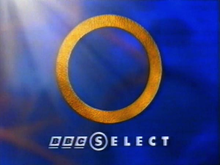BBC Select
| BBC Select | |
|---|---|
 |
|
| Launched | 21 January 1992 |
| Closed | 1994 |
| Owned by | BBC |
| Slogan | When you switch off, we switch on. |
|
Availability
At time of closure |
|
| Terrestrial | |
| UK Analogue |
BBC1 BBC2 |
BBC Select was an overnight television service run by the BBC during the hours when BBC1 or BBC2 had closed down, usually between 2am and 6am. The channel showed programming intended for specialist audiences, such as businessmen, lawyers, nurses and teachers, and was designed to be viewed after broadcast via a video recording. It was funded by a subscription, and most programming was scrambled.
The service was officially launched on 21 January 1992 overnight, and ran on both BBC1 and 2. The service experimented with programming for specific audiences, and with overnight broadcasts, experience that the BBC would later use when broadcasting the BBC Learning Zone. By broadcasting the programming now, it allowed the BBC to broaden their audience, while allowing more time in the day for other programming.
The programming was specifically aimed at the professional services of business, nurses, teachers and lawyers with programming made in-house by the BBC with some programming supplied by other independent companies as part of their remit. An example of this was Thames Television whose film Living with Disabilities, and their series The Way Ahead, both made for the Department of Social Security, were distributed free, on condition that no financial gain be made from it: as a result the programme was broadcast un-encrypted.
Corporate companies also took advantage of the service. In 1992 and 1993 Cable & Wireless used BBC Select to broadcast highlights of their annual general meeting (AGM). The first broadcast, of their 1992 AGM, was the first time in the UK that a company AGM had been televised. These highlights were broadcast unencrypted.
To watch programming, a set-top box, or BBC Selector and BBC Select viewing card was required which both decoded and unscrambled the programme. The box also received signals, sent out prior to the programme start, that would alert the box to the fact the programme was starting. The box would then trigger VCRs to begin recording by sending out a pulse of Infrared to set off the VCR's recorder, as if the viewer had pressed the record button.
...
Wikipedia
